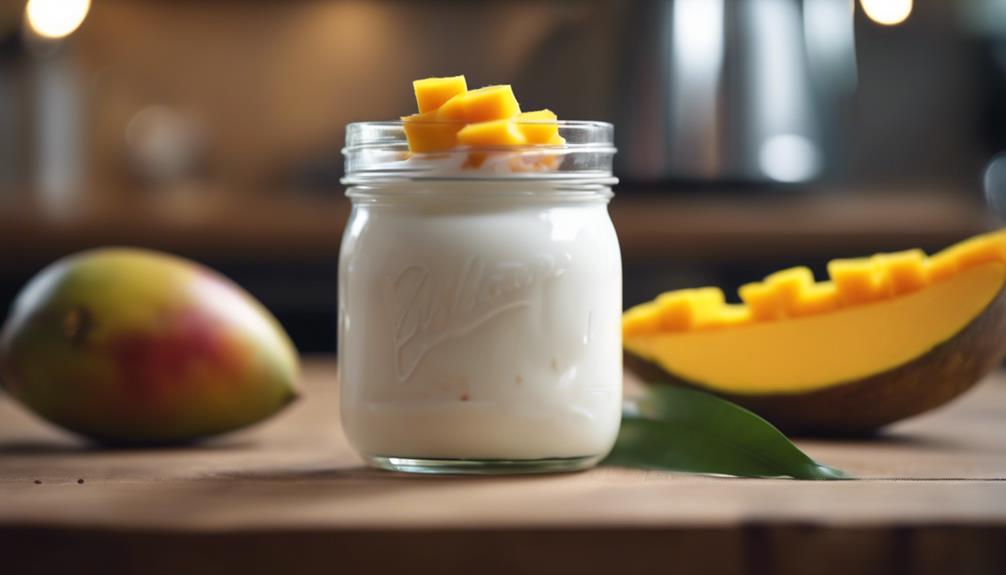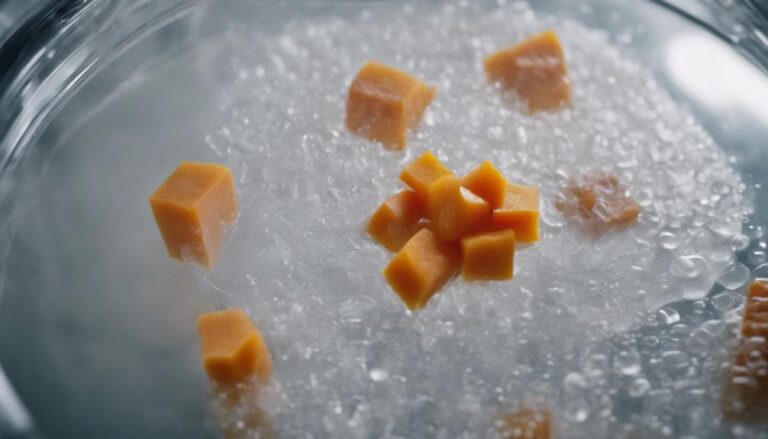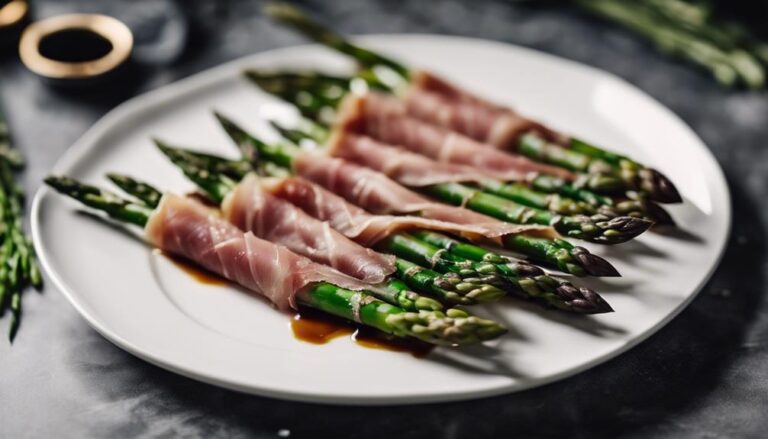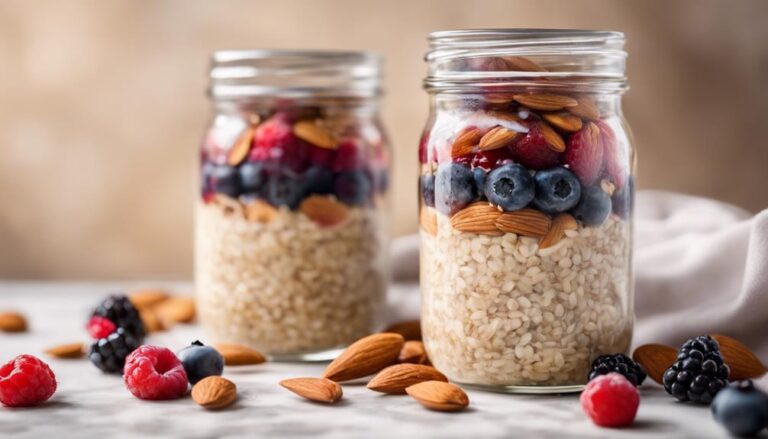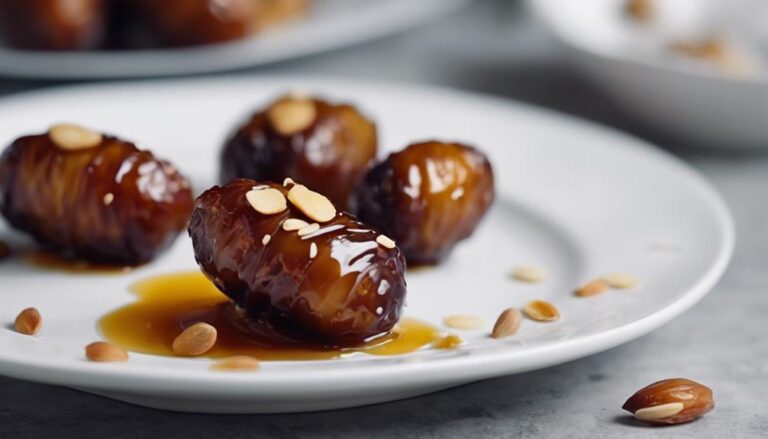Sous Vide Coconut Yogurt With Fresh Mango
To craft Sous Vide Coconut Yogurt with Fresh Mango, make sure you have a sous vide machine for precise temperature. Select quality coconut milk and ripe mango for enhanced flavor. Use airtight containers during fermentation. Monitor closely for best results. The meticulous process guarantees a velvety texture and intensified taste. Perfecting this blend will lead to a delightful treat for your palate.
What You Will Learn Here
- Sous vide method ensures consistent and precise temperature control for optimal yogurt fermentation.
- Fresh mango adds a refreshing and tropical twist to the creamy coconut yogurt.
- Enhanced coconut flavor through sous vide technique creates a rich taste experience.
- Velvety smooth texture achieved by controlled temperature eliminates unwanted bacteria growth.
- Harmonious blend of flavors between coconut yogurt and fresh mango for a delightful indulgence.
Yogurt-Making Techniques
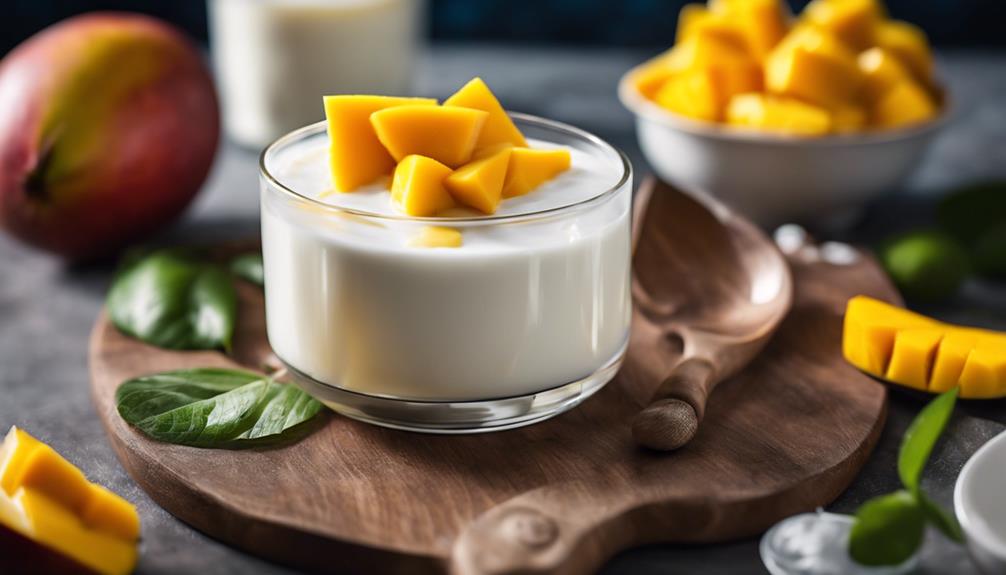
To make yogurt successfully, you need to understand the types of cultures suitable for fermentation. Different strains of cultures can influence the flavor and consistency of the yogurt. Comprehend the fermentation process, as it is vital for achieving the desired texture and taste. Having the right equipment, such as a yogurt maker or sous vide machine, is essential for maintaining the ideal conditions throughout the fermentation process.
Types of Cultures
Utilizing specific strains of bacteria and yeast, various cultures are employed in the process of yogurt-making to ferment milk and produce the desired consistency and flavor profiles.
Bacterial strains such as Lactobacillus bulgaricus and Streptococcus thermophilus are commonly used in traditional yogurt production, initiating the fermentation process that converts lactose into lactic acid.
These probiotic cultures not only contribute to the tangy taste and creamy texture of yogurt but also offer numerous health benefits, including improved digestion and strengthened immune system.
In modern yogurt-making, innovative variations like Bifidobacterium and Lactobacillus acidophilus are introduced to enhance the probiotic content, promoting gut health and overall well-being.
Experimenting with different cultures can lead to unique flavor combinations and nutritional advantages, catering to diverse consumer preferences.
Fermentation Process
In the process of yogurt-making, the fermentation stage is essential for transforming milk into yogurt through the action of specific bacterial cultures. Fermentation benefits include the breakdown of lactose into lactic acid, giving yogurt its characteristic tangy flavor and thick texture.
Techniques for fermentation involve maintaining a consistent temperature to promote bacterial growth and acid production. Flavor customization is achieved by adjusting fermentation time and temperature, allowing for variations in taste and texture. Longer fermentation times can result in a tangier yogurt, while shorter times produce a milder flavor.
Equipment Needed
For effective yogurt-making techniques, make sure you have the necessary equipment readily available. Temperature control is essential; you'll need a sous vide machine to maintain a consistent temperature throughout the process. This guarantees the yogurt ferments properly without any fluctuations that could impact the final product.
Flavor infusion can be achieved with airtight containers or mason jars for mixing in ingredients like coconut milk and probiotic cultures. Time management is key; set a timer for the desired fermentation period and monitor it closely.
When it comes to ingredient sourcing, opt for high-quality coconut milk and fresh mango to enhance the taste of your yogurt. Having the right equipment at hand will streamline the yogurt-making process and lead to delicious results.
Key Yogurt Components
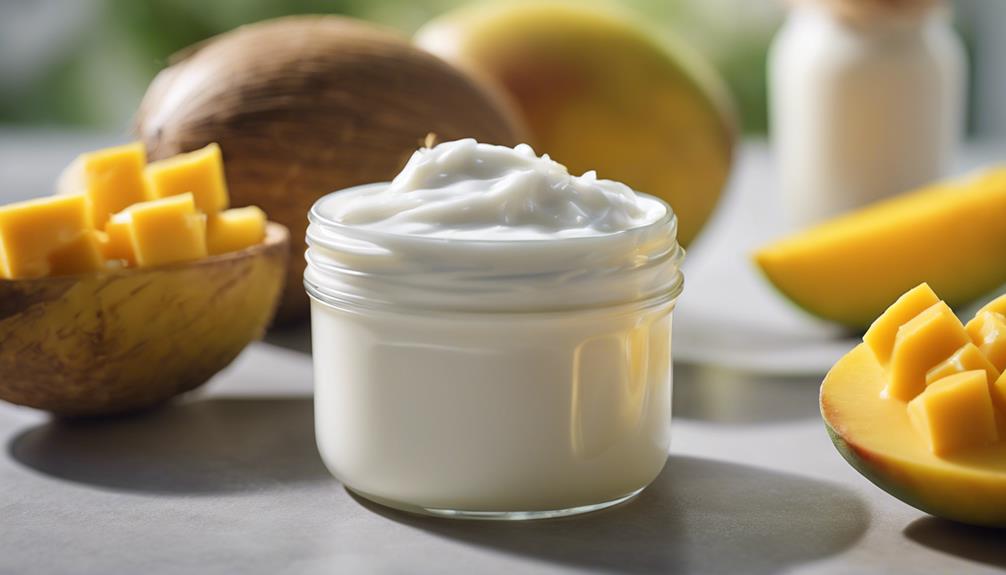
When creating yogurt, understanding the key components is essential for achieving the desired texture and flavor. Here are some vital elements to take into account:
- Flavor Profiles: Different yogurt cultures produce varying flavor profiles, ranging from tangy to mild and creamy. Experimenting with different cultures can lead to unique and exciting taste experiences that can elevate your yogurt creations.
- Nutritional Benefits: Yogurt is a rich source of essential nutrients like calcium, protein, and probiotics. Choosing the right components can enhance the nutritional value of your yogurt, making it not only delicious but also a healthy addition to your diet.
- Probiotic Strains: The selection of probiotic strains in yogurt can impact both its taste and health benefits. Understanding the role of probiotics in yogurt can help you create gut-friendly options that promote digestive health.
Innovating with these key yogurt components can open up a world of possibilities for crafting delicious and nutritious yogurt varieties that cater to your preferences and dietary needs.
Mango-Infused Yogurt Creations
Explore a coconut mango yogurt recipe that combines the tropical flavors of coconut and mango in a creamy, tangy yogurt base.
Discover the invigorating taste of a mango lassi yogurt blend, blending the sweetness of mango with the subtle tartness of yogurt.
Indulge in a decadent creamy mango yogurt swirl that offers a delightful balance of sweet and tangy notes in every spoonful.
Coconut Mango Yogurt Recipe
Creating a vibrant and creamy coconut mango yogurt involves infusing the rich flavors of ripe mangoes into a base of smooth yogurt. To craft this innovative treat, follow these precise steps:
- Mango Selection: Carefully choose the ripest mangoes for an intense tropical flavor profile.
- Blending Technique: Utilize a high-powered blender for a silky smooth yogurt consistency.
- Infusion Method: Gently fold in the mango puree to guarantee a balanced fusion of flavors.
Mango Lassi Yogurt Blend
For the ideal infusion of mango flavors into your yogurt blend, consider experimenting with varying ratios of mango puree to achieve the desired taste intensity. Incorporating elements like a mango smoothie or coconut milk can elevate the richness of your creation.
Here are some key factors to keep in mind:
- Texture: Blend the mango puree until smooth to guarantee a silky consistency.
- Taste Balance: Adjust the amount of mango puree added to strike the perfect harmony between sweetness and tanginess.
- Chilling Time: Allow the yogurt blend to rest in the refrigerator for a few hours to intensify the flavors and create a revitalizing treat.
Creamy Mango Yogurt Swirl
To enhance the mango infusion in your yogurt creations, consider blending creamy mango puree with tangy yogurt to create a luscious and tropical swirl. When aiming for a perfect marriage of flavors and textures, the following points are important for creating a delightful mango-infused yogurt experience:
- Mango puree: Utilize ripe, sweet mango puree to infuse your yogurt with a burst of tropical flavor.
- Yogurt texture: Make sure the yogurt base is creamy and smooth to achieve a luxurious mouthfeel in every spoonful.
- Swirling technique: Master the art of swirling the mango puree into the yogurt to create visually appealing patterns that enhance the overall dining experience.
Yogurt-Setting Temperature Guidelines
When setting yogurt temperatures, you must adhere to ideal ranges to achieve the desired consistency. Precision is key in maintaining the integrity of the yogurt culture and ensuring a successful outcome.
Consistency in temperature control is essential for replicating results with each batch.
Optimal Temperature Ranges
Maintain precise control over the temperature settings to achieve the ideal range for setting your yogurt effectively. Temperature control is essential for fermentation efficiency, with the ideal range typically falling between 110°F to 115°F (43°C to 46°C).
This range encourages the growth of beneficial bacteria while inhibiting the growth of harmful pathogens. By staying within this temperature window, you promote a balanced fermentation process that enhances flavor development and texture optimization.
Deviating from this range may result in inconsistent yogurt texture or undesirable flavors. Utilizing a sous vide precision cooker can help you maintain these precise temperatures consistently, ensuring that your coconut yogurt achieves the perfect balance of tanginess and creaminess.
Importance of Precision
For optimal yogurt-setting results, precise temperature control within the specified range is essential to promote the growth of beneficial bacteria and prevent the proliferation of harmful pathogens. Temperature control and fermentation accuracy are key factors in ensuring the success of your yogurt-making process.
When aiming for precision, consider the importance of timing and culture selection. Maintaining the recommended temperature range during the fermentation process is vital for the proper development of the yogurt's texture and flavor. By carefully monitoring and adjusting the temperature, you can create a conducive environment for the cultures to thrive, resulting in a delicious and healthy coconut yogurt.
Consistency in Results
To achieve consistent yogurt-setting results, adherence to specific temperature guidelines is essential for the ideal growth and development of beneficial bacteria while inhibiting harmful pathogens. When engaging in flavor experimentation, sourcing high-quality ingredients is key. Time management plays an important role in the yogurt-making process, and precise temperature control is essential to ensuring the desired texture and taste.
Final Thoughts
Consider the key takeaways from this process as you reflect on the creation of your Sous Vide Coconut Yogurt with Fresh Mango. Reflections on taste preferences reveal that the delicate balance between the creamy coconut yogurt and the sweet tang of fresh mango creates a harmonious blend of flavors that's both invigorating and indulgent. The sous vide method not only guarantees a consistent texture but also intensifies the coconut flavor, elevating the overall taste experience.
Furthermore, the controlled temperature of the sous vide cooking technique allows for the perfect incubation environment, resulting in a velvety smooth yogurt that's free from any unwanted bacteria. This precision in temperature regulation ensures food safety while promoting the growth of beneficial probiotics, enhancing the yogurt's nutritional value.
Frequently Asked Questions
Can I Use Canned Coconut Milk for Making the Yogurt?
Yes, you can use canned coconut milk as an alternative for making yogurt. Make sure the can is unopened, check the expiration date, and store it in a cool place, as temperature affects the shelf life of coconut milk.
How Long Will the Yogurt Stay Fresh in the Refrigerator?
To keep the yogurt fresh in the refrigerator, store it at a controlled temperature of 35-40°F. The duration varies based on fermentation and flavor preferences, typically lasting 1-2 weeks. Explore different storage methods to enhance flavors and extend the shelf life.
Can I Substitute Mango With Other Fruits in the Recipe?
When substituting fruits, consider texture and sweetness levels. While mango provides a tropical touch, other fruits like berries or peaches can offer unique flavors. Experiment with various fruits to create diverse flavor profiles while maintaining the desired texture.
Is It Possible to Overcook the Yogurt in the Sous Vide?
You can overcook yogurt in the sous vide. Exceeding cooking time alters texture, resulting in a grainy consistency. Temperature control is essential to maintain the desired creamy texture and flavor profile. Monitor closely to avoid overcooking.
Can I Add Sweeteners Like Honey or Sugar to the Yogurt While Cooking?
Yes, you can add sweeteners like honey or sugar to the yogurt while cooking. Experiment with different sweetener options to suit your flavor preferences. Adjust cooking techniques and recipe variations accordingly for a personalized touch.
Conclusion
To sum up, sous vide coconut yogurt with fresh mango is a delectable and nourishing treat that can be easily prepared at home.
By following the proper yogurt-making techniques and temperature guidelines, you can create a smooth and flavorful yogurt infused with the tropical taste of mango.
Experiment with different variations and toppings to personalize your yogurt creations to match your taste preferences.
Indulge in the health benefits and delightful flavors of this homemade yogurt dish.
